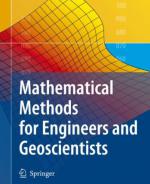Добрый день, Коллеги. Важное сообщение, просьба принять участие. Музей Ферсмана ищет помощь для реставрационных работ в помещении. Подробности по ссылке
Математические методы для инженеров и геологов (Mathematical methods for engineers and geoscientists)
This work is subject to copyright. All rights are reserved, whether the whole or part of the material is concerned, specifically the rights of translation, reprinting, reuse of illustrations, recitation, broadcasting, reproduction on microfilm or in any other way, and storage in data banks. Duplication of this publication or parts thereof is permitted only under the provisions of the German Copyright Law of September 9, 1965, in its current version, and permission for use must always be obtained from Springer. Violations are liable to prosecution under the German Copyright Law. The use of general descriptive names, registered names, trademarks, etc. in this publication does not imply, even in the absence of a specific statement, that such names are exempt from the relevant protective laws and regulations and therefore free for general use. We start with a fun puzzle in mathematics and mathematical methods. How many corners does a four-dimensional cube have? Does such a thing exist, you ask? You may be a geoscientist or a philosopher. If your answer is: there are surely more than the eight corners there are for a three-dimensional cube, you are an engineer. If you know without hesitation that there are exactly sixteen corners and you can prove why, you are a mathematician. To explain the goal of this book, I refer to Hersh (1997): The United States suffers from “innumeracy” in its general population, “math avoidance” among high-school students, and 50 percent failure among college calculus students. Causes include starvation budgets in the school, mental attrition by television, parents who don’t like math. There’s another, unrecognized cause of failure: misconception of the nature of mathematics. I think the specific reference to the United States may be omitted. It is really a worldwide problem. Moreover, there is one more consequence of “math avoidance” and “misconception”: good mathematical approaches are sometimes applied incorrectly. Particularly, the methods of statistics are often misused for different goals. Applying mathematical methods is similar to using nuclear power: the final results depend on the competence of the user. I try to convince my readers to apply the “energy” of mathematics with consideration. This book does not require special knowledge of pure mathematics. Equations and calculations are mostly rooted in high-school algebra, and the reader needs only a healthy human mind in order to understand them. This book is unusual in one sense, as unlike most mathematics books, it starts with some real problems and presentations and discussions follow. This volume does not provide an invincible solution for the problem of “misconception” nor does it offer suggestions for classroom practice. It can assist in the education of engineers and geoscientists by helping them to understand the usefulness of diverse mathematical approaches. My first priority is to present these approaches in language that an engineer or a geoscientist can understand. I try to explain the mathematical methods as I do in my lectures for nonmathematicians, something akin to looking through special spectacles at so-called mathematical reality. In 1992
the great British mathematician G. H. Hardy in A Mathematician’s Apology wrote about this in an amusing way:
A chair or a star is not in the least like what it seems to be; the more we think of it, the fuzzier its outlines become in the haze of sensation which surrounds it; but “2” or “317” has nothing to do with sensation, and its properties stand out the more clearly the more closely we scrutinize it. It may be that modern physics fits best into some framework of idealistic philosophy. I do not believe it, but there are eminent physicists who say so. Pure mathematics, on the other hand, seems to me a rock on which all idealism founders: 317 is prime, not because we think so, or because our minds are shaped in one way rather than another, but because it is so, because mathematical reality is built that way. We avoid the temptation to try and convince readers that mathematical reality does exist, as any discussion on this issue is similar to discussions about God. One either believes or does not believe. This is a special space, a cosmos where pure mathematicians live and work. However, some methods and approaches that are
developed in this cosmos are undoubtedly useful for engineers and geoscientists. This book is structured simply. Chapter 1 offers an introduction that is seldom




